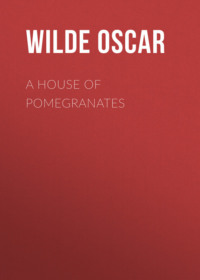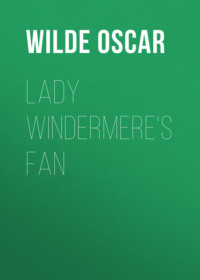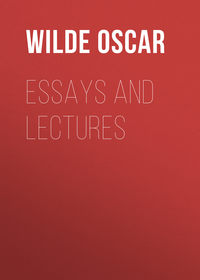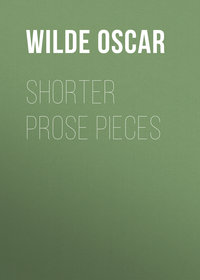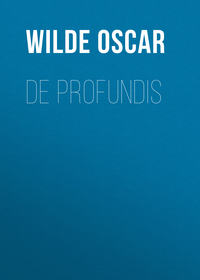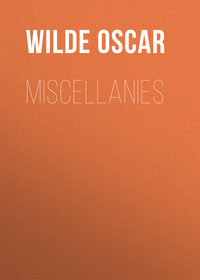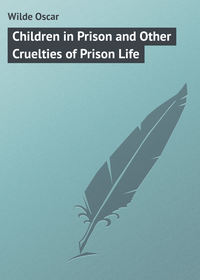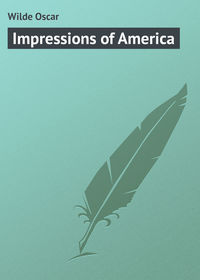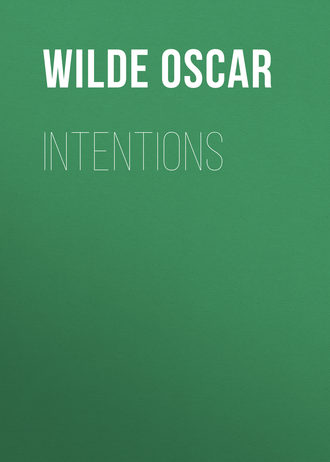 полная версия
полная версияIntentions
Cyril. The theory is certainly a very curious one, but to make it complete you must show that Nature, no less than Life, is an imitation of Art. Are you prepared to prove that?
Vivian. My dear fellow, I am prepared to prove anything.
Cyril. Nature follows the landscape painter, then, and takes her effects from him?
Vivian. Certainly. Where, if not from the Impressionists, do we get those wonderful brown fogs that come creeping down our streets, blurring the gas-lamps and changing the houses into monstrous shadows? To whom, if not to them and their master, do we owe the lovely silver mists that brood over our river, and turn to faint forms of fading grace curved bridge and swaying barge? The extraordinary change that has taken place in the climate of London during the last ten years is entirely due to a particular school of Art. You smile. Consider the matter from a scientific or a metaphysical point of view, and you will find that I am right. For what is Nature? Nature is no great mother who has borne us. She is our creation. It is in our brain that she quickens to life. Things are because we see them, and what we see, and how we see it, depends on the Arts that have influenced us. To look at a thing is very different from seeing a thing. One does not see anything until one sees its beauty. Then, and then only, does it come into existence. At present, people see fogs, not because there are fogs, but because poets and painters have taught them the mysterious loveliness of such effects. There may have been fogs for centuries in London. I dare say there were. But no one saw them, and so we do not know anything about them. They did not exist till Art had invented them. Now, it must be admitted, fogs are carried to excess. They have become the mere mannerism of a clique, and the exaggerated realism of their method gives dull people bronchitis. Where the cultured catch an effect, the uncultured catch cold. And so, let us be humane, and invite Art to turn her wonderful eyes elsewhere. She has done so already, indeed. That white quivering sunlight that one sees now in France, with its strange blotches of mauve, and its restless violet shadows, is her latest fancy, and, on the whole, Nature reproduces it quite admirably. Where she used to give us Corots and Daubignys, she gives us now exquisite Monets and entrancing Pissaros. Indeed there are moments, rare, it is true, but still to be observed from time to time, when Nature becomes absolutely modern. Of course she is not always to be relied upon. The fact is that she is in this unfortunate position. Art creates an incomparable and unique effect, and, having done so, passes on to other things. Nature, upon the other hand, forgetting that imitation can be made the sincerest form of insult, keeps on repeating this effect until we all become absolutely wearied of it. Nobody of any real culture, for instance, ever talks nowadays about the beauty of a sunset. Sunsets are quite old-fashioned. They belong to the time when Turner was the last note in art. To admire them is a distinct sign of provincialism of temperament. Upon the other hand they go on. Yesterday evening Mrs. Arundel insisted on my going to the window, and looking at the glorious sky, as she called it. Of course I had to look at it. She is one of those absurdly pretty Philistines to whom one can deny nothing. And what was it? It was simply a very second-rate Turner, a Turner of a bad period, with all the painter’s worst faults exaggerated and over-emphasised. Of course, I am quite ready to admit that Life very often commits the same error. She produces her false Renés and her sham Vautrins, just as Nature gives us, on one day a doubtful Cuyp, and on another a more than questionable Rousseau. Still, Nature irritates one more when she does things of that kind. It seems so stupid, so obvious, so unnecessary. A false Vautrin might be delightful. A doubtful Cuyp is unbearable. However, I don’t want to be too hard on Nature. I wish the Channel, especially at Hastings, did not look quite so often like a Henry Moore, grey pearl with yellow lights, but then, when Art is more varied, Nature will, no doubt, be more varied also. That she imitates Art, I don’t think even her worst enemy would deny now. It is the one thing that keeps her in touch with civilised man. But have I proved my theory to your satisfaction?
Cyril. You have proved it to my dissatisfaction, which is better. But even admitting this strange imitative instinct in Life and Nature, surely you would acknowledge that Art expresses the temper of its age, the spirit of its time, the moral and social conditions that surround it, and under whose influence it is produced.
Vivian. Certainly not! Art never expresses anything but itself. This is the principle of my new æsthetics; and it is this, more than that vital connection between form and substance, on which Mr. Pater dwells, that makes music the type of all the arts. Of course, nations and individuals, with that healthy natural vanity which is the secret of existence, are always under the impression that it is of them that the Muses are talking, always trying to find in the calm dignity of imaginative art some mirror of their own turbid passions, always forgetting that the singer of life is not Apollo but Marsyas. Remote from reality, and with her eyes turned away from the shadows of the cave, Art reveals her own perfection, and the wondering crowd that watches the opening of the marvellous, many-petalled rose fancies that it is its own history that is being told to it, its own spirit that is finding expression in a new form. But it is not so. The highest art rejects the burden of the human spirit, and gains more from a new medium or a fresh material than she does from any enthusiasm for art, or from any lofty passion, or from any great awakening of the human consciousness. She develops purely on her own lines. She is not symbolic of any age. It is the ages that are her symbols.
Even those who hold that Art is representative of time and place and people cannot help admitting that the more imitative an art is, the less it represents to us the spirit of its age. The evil faces of the Roman emperors look out at us from the foul porphyry and spotted jasper in which the realistic artists of the day delighted to work, and we fancy that in those cruel lips and heavy sensual jaws we can find the secret of the ruin of the Empire. But it was not so. The vices of Tiberius could not destroy that supreme civilisation, any more than the virtues of the Antonines could save it. It fell for other, for less interesting reasons. The sibyls and prophets of the Sistine may indeed serve to interpret for some that new birth of the emancipated spirit that we call the Renaissance; but what do the drunken boors and bawling peasants of Dutch art tell us about the great soul of Holland? The more abstract, the more ideal an art is, the more it reveals to us the temper of its age. If we wish to understand a nation by means of its art, let us look at its architecture or its music.
Cyril. I quite agree with you there. The spirit of an age may be best expressed in the abstract ideal arts, for the spirit itself is abstract and ideal. Upon the other hand, for the visible aspect of an age, for its look, as the phrase goes, we must of course go to the arts of imitation.
Vivian. I don’t think so. After all, what the imitative arts really give us are merely the various styles of particular artists, or of certain schools of artists. Surely you don’t imagine that the people of the Middle Ages bore any resemblance at all to the figures on mediæval stained glass, or in mediæval stone and wood carving, or on mediæval metal-work, or tapestries, or illuminated MSS. They were probably very ordinary-looking people, with nothing grotesque, or remarkable, or fantastic in their appearance. The Middle Ages, as we know them in art, are simply a definite form of style, and there is no reason at all why an artist with this style should not be produced in the nineteenth century. No great artist ever sees things as they really are. If he did, he would cease to be an artist. Take an example from our own day. I know that you are fond of Japanese things. Now, do you really imagine that the Japanese people, as they are presented to us in art, have any existence? If you do, you have never understood Japanese art at all. The Japanese people are the deliberate self-conscious creation of certain individual artists. If you set a picture by Hokusai, or Hokkei, or any of the great native painters, beside a real Japanese gentleman or lady, you will see that there is not the slightest resemblance between them. The actual people who live in Japan are not unlike the general run of English people; that is to say, they are extremely commonplace, and have nothing curious or extraordinary about them. In fact the whole of Japan is a pure invention. There is no such country, there are no such people. One of our most charming painters went recently to the Land of the Chrysanthemum in the foolish hope of seeing the Japanese. All he saw, all he had the chance of painting, were a few lanterns and some fans. He was quite unable to discover the inhabitants, as his delightful exhibition at Messrs. Dowdeswell’s Gallery showed only too well. He did not know that the Japanese people are, as I have said, simply a mode of style, an exquisite fancy of art. And so, if you desire to see a Japanese effect, you will not behave like a tourist and go to Tokio. On the contrary, you will stay at home and steep yourself in the work of certain Japanese artists, and then, when you have absorbed the spirit of their style, and caught their imaginative manner of vision, you will go some afternoon and sit in the Park or stroll down Piccadilly, and if you cannot see an absolutely Japanese effect there, you will not see it anywhere. Or, to return again to the past, take as another instance the ancient Greeks. Do you think that Greek art ever tells us what the Greek people were like? Do you believe that the Athenian women were like the stately dignified figures of the Parthenon frieze, or like those marvellous goddesses who sat in the triangular pediments of the same building? If you judge from the art, they certainly were so. But read an authority, like Aristophanes, for instance. You will find that the Athenian ladies laced tightly, wore high-heeled shoes, dyed their hair yellow, painted and rouged their faces, and were exactly like any silly fashionable or fallen creature of our own day. The fact is that we look back on the ages entirely through the medium of art, and art, very fortunately, has never once told us the truth.
Cyril. But modern portraits by English painters, what of them? Surely they are like the people they pretend to represent?
Vivian. Quite so. They are so like them that a hundred years from now no one will believe in them. The only portraits in which one believes are portraits where there is very little of the sitter, and a very great deal of the artist. Holbein’s drawings of the men and women of his time impress us with a sense of their absolute reality. But this is simply because Holbein compelled life to accept his conditions, to restrain itself within his limitations, to reproduce his type, and to appear as he wished it to appear. It is style that makes us believe in a thing – nothing but style. Most of our modern portrait painters are doomed to absolute oblivion. They never paint what they see. They paint what the public sees, and the public never sees anything.
Cyril. Well, after that I think I should like to hear the end of your article.
Vivian. With pleasure. Whether it will do any good I really cannot say. Ours is certainly the dullest and most prosaic century possible. Why, even Sleep has played us false, and has closed up the gates of ivory, and opened the gates of horn. The dreams of the great middle classes of this country, as recorded in Mr. Myers’s two bulky volumes on the subject, and in the Transactions of the Psychical Society, are the most depressing things that I have ever read. There is not even a fine nightmare among them. They are commonplace, sordid and tedious. As for the Church, I cannot conceive anything better for the culture of a country than the presence in it of a body of men whose duty it is to believe in the supernatural, to perform daily miracles, and to keep alive that mythopoeic faculty which is so essential for the imagination. But in the English Church a man succeeds, not through his capacity for belief, but through his capacity for disbelief. Ours is the only Church where the sceptic stands at the altar, and where St. Thomas is regarded as the ideal apostle. Many a worthy clergyman, who passes his life in admirable works of kindly charity, lives and dies unnoticed and unknown; but it is sufficient for some shallow uneducated passman out of either University to get up in his pulpit and express his doubts about Noah’s ark, or Balaam’s ass, or Jonah and the whale, for half of London to flock to hear him, and to sit open-mouthed in rapt admiration at his superb intellect. The growth of common sense in the English Church is a thing very much to be regretted. It is really a degrading concession to a low form of realism. It is silly, too. It springs from an entire ignorance of psychology. Man can believe the impossible, but man can never believe the improbable. However, I must read the end of my article: —
‘What we have to do, what at any rate it is our duty to do, is to revive this old art of Lying. Much of course may be done, in the way of educating the public, by amateurs in the domestic circle, at literary lunches, and at afternoon teas. But this is merely the light and graceful side of lying, such as was probably heard at Cretan dinner-parties. There are many other forms. Lying for the sake of gaining some immediate personal advantage, for instance – lying with a moral purpose, as it is usually called – though of late it has been rather looked down upon, was extremely popular with the antique world. Athena laughs when Odysseus tells her “his words of sly devising,” as Mr. William Morris phrases it, and the glory of mendacity illumines the pale brow of the stainless hero of Euripidean tragedy, and sets among the noble women of the past the young bride of one of Horace’s most exquisite odes. Later on, what at first had been merely a natural instinct was elevated into a self-conscious science. Elaborate rules were laid down for the guidance of mankind, and an important school of literature grew up round the subject. Indeed, when one remembers the excellent philosophical treatise of Sanchez on the whole question, one cannot help regretting that no one has ever thought of publishing a cheap and condensed edition of the works of that great casuist. A short primer, “When to Lie and How,” if brought out in an attractive and not too expensive a form, would no doubt command a large sale, and would prove of real practical service to many earnest and deep-thinking people. Lying for the sake of the improvement of the young, which is the basis of home education, still lingers amongst us, and its advantages are so admirably set forth in the early books of Plato’s Republic that it is unnecessary to dwell upon them here. It is a mode of lying for which all good mothers have peculiar capabilities, but it is capable of still further development, and has been sadly overlooked by the School Board. Lying for the sake of a monthly salary is of course well known in Fleet Street, and the profession of a political leader-writer is not without its advantages. But it is said to be a somewhat dull occupation, and it certainly does not lead to much beyond a kind of ostentatious obscurity. The only form of lying that is absolutely beyond reproach is lying for its own sake, and the highest development of this is, as we have already pointed out, Lying in Art. Just as those who do not love Plato more than Truth cannot pass beyond the threshold of the Academe, so those who do not love Beauty more than Truth never know the inmost shrine of Art. The solid stolid British intellect lies in the desert sands like the Sphinx in Flaubert’s marvellous tale, and fantasy, La Chimère, dances round it, and calls to it with her false, flute-toned voice. It may not hear her now, but surely some day, when we are all bored to death with the commonplace character of modern fiction, it will hearken to her and try to borrow her wings.
‘And when that day dawns, or sunset reddens, how joyous we shall all be! Facts will be regarded as discreditable, Truth will be found mourning over her fetters, and Romance, with her temper of wonder, will return to the land. The very aspect of the world will change to our startled eyes. Out of the sea will rise Behemoth and Leviathan, and sail round the high-pooped galleys, as they do on the delightful maps of those ages when books on geography were actually readable. Dragons will wander about the waste places, and the phoenix will soar from her nest of fire into the air. We shall lay our hands upon the basilisk, and see the jewel in the toad’s head. Champing his gilded oats, the Hippogriff will stand in our stalls, and over our heads will float the Blue Bird singing of beautiful and impossible things, of things that are lovely and that never happen, of things that are not and that should be. But before this comes to pass we must cultivate the lost art of Lying.’
Cyril. Then we must entirely cultivate it at once. But in order to avoid making any error I want you to tell me briefly the doctrines of the new æsthetics.
Vivian. Briefly, then, they are these. Art never expresses anything but itself. It has an independent life, just as Thought has, and develops purely on its own lines. It is not necessarily realistic in an age of realism, nor spiritual in an age of faith. So far from being the creation of its time, it is usually in direct opposition to it, and the only history that it preserves for us is the history of its own progress. Sometimes it returns upon its footsteps, and revives some antique form, as happened in the archaistic movement of late Greek Art, and in the pre-Raphaelite movement of our own day. At other times it entirely anticipates its age, and produces in one century work that it takes another century to understand, to appreciate and to enjoy. In no case does it reproduce its age. To pass from the art of a time to the time itself is the great mistake that all historians commit.
The second doctrine is this. All bad art comes from returning to Life and Nature, and elevating them into ideals. Life and Nature may sometimes be used as part of Art’s rough material, but before they are of any real service to art they must be translated into artistic conventions. The moment Art surrenders its imaginative medium it surrenders everything. As a method Realism is a complete failure, and the two things that every artist should avoid are modernity of form and modernity of subject-matter. To us, who live in the nineteenth century, any century is a suitable subject for art except our own. The only beautiful things are the things that do not concern us. It is, to have the pleasure of quoting myself, exactly because Hecuba is nothing to us that her sorrows are so suitable a motive for a tragedy. Besides, it is only the modern that ever becomes old-fashioned. M. Zola sits down to give us a picture of the Second Empire. Who cares for the Second Empire now? It is out of date. Life goes faster than Realism, but Romanticism is always in front of Life.
The third doctrine is that Life imitates Art far more than Art imitates Life. This results not merely from Life’s imitative instinct, but from the fact that the self-conscious aim of Life is to find expression, and that Art offers it certain beautiful forms through which it may realise that energy. It is a theory that has never been put forward before, but it is extremely fruitful, and throws an entirely new light upon the history of Art.
It follows, as a corollary from this, that external Nature also imitates Art. The only effects that she can show us are effects that we have already seen through poetry, or in paintings. This is the secret of Nature’s charm, as well as the explanation of Nature’s weakness.
The final revelation is that Lying, the telling of beautiful untrue things, is the proper aim of Art. But of this I think I have spoken at sufficient length. And now let us go out on the terrace, where ‘droops the milk-white peacock like a ghost,’ while the evening star ‘washes the dusk with silver.’ At twilight nature becomes a wonderfully suggestive effect, and is not without loveliness, though perhaps its chief use is to illustrate quotations from the poets. Come! We have talked long enough.
PEN, PENCIL AND POISON
A STUDY IN GREEN
It has constantly been made a subject of reproach against artists and men of letters that they are lacking in wholeness and completeness of nature. As a rule this must necessarily be so. That very concentration of vision and intensity of purpose which is the characteristic of the artistic temperament is in itself a mode of limitation. To those who are preoccupied with the beauty of form nothing else seems of much importance. Yet there are many exceptions to this rule. Rubens served as ambassador, and Goethe as state councillor, and Milton as Latin secretary to Cromwell. Sophocles held civic office in his own city; the humourists, essayists, and novelists of modern America seem to desire nothing better than to become the diplomatic representatives of their country; and Charles Lamb’s friend, Thomas Griffiths Wainewright, the subject of this brief memoir, though of an extremely artistic temperament, followed many masters other than art, being not merely a poet and a painter, an art-critic, an antiquarian, and a writer of prose, an amateur of beautiful things, and a dilettante of things delightful, but also a forger of no mean or ordinary capabilities, and as a subtle and secret poisoner almost without rival in this or any age.
This remarkable man, so powerful with ‘pen, pencil and poison,’ as a great poet of our own day has finely said of him, was born at Chiswick, in 1794. His father was the son of a distinguished solicitor of Gray’s Inn and Hatton Garden. His mother was the daughter of the celebrated Dr. Griffiths, the editor and founder of the Monthly Review, the partner in another literary speculation of Thomas Davis, that famous bookseller of whom Johnson said that he was not a bookseller, but ‘a gentleman who dealt in books,’ the friend of Goldsmith and Wedgwood, and one of the most well-known men of his day. Mrs. Wainewright died, in giving him birth, at the early age of twenty-one, and an obituary notice in the Gentleman’s Magazine tells us of her ‘amiable disposition and numerous accomplishments,’ and adds somewhat quaintly that ‘she is supposed to have understood the writings of Mr. Locke as well as perhaps any person of either sex now living.’ His father did not long survive his young wife, and the little child seems to have been brought up by his grandfather, and, on the death of the latter in 1803, by his uncle George Edward Griffiths, whom he subsequently poisoned. His boyhood was passed at Linden House, Turnham Green, one of those many fine Georgian mansions that have unfortunately disappeared before the inroads of the suburban builder, and to its lovely gardens and well-timbered park he owed that simple and impassioned love of nature which never left him all through his life, and which made him so peculiarly susceptible to the spiritual influences of Wordsworth’s poetry. He went to school at Charles Burney’s academy at Hammersmith. Mr. Burney was the son of the historian of music, and the near kinsman of the artistic lad who was destined to turn out his most remarkable pupil. He seems to have been a man of a good deal of culture, and in after years Mr. Wainewright often spoke of him with much affection as a philosopher, an archæologist, and an admirable teacher who, while he valued the intellectual side of education, did not forget the importance of early moral training. It was under Mr. Burney that he first developed his talent as an artist, and Mr. Hazlitt tells us that a drawing-book which he used at school is still extant, and displays great talent and natural feeling. Indeed, painting was the first art that fascinated him. It was not till much later that he sought to find expression by pen or poison.


